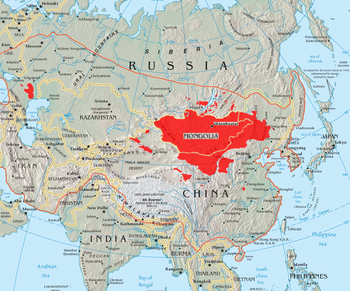
Back Región de Mongolia Spanish Mongolia (alue) Finnish Grande Mongolie French Grande Mongolia Italian 蒙古 Japanese Монгол нутаг Mongolian Mongolia (region) Polish Монголосфера Russian Велика Монголія Ukrainian

The Mongol heartland[1] or Mongolian heartland[2] refers to the contiguous geographical area in which the Mongol people have primarily lived,[3] especially in history books. It is generally considered to comprise the Mongolian Plateau and some adjacent territories, although its exact extent has been changing over the course of history—particularly since the rise of the Mongol Empire in the 13th century. The area is also described as the heartland of the Mongol Empire during its greatest extent, when it stretched from the Sea of Japan in the east to the Middle East and Eastern Europe in the west, making it the largest contiguous land empire in human history.
The modern area that the Mongols live in approximately includes: the modern state of Mongolia; the Inner Mongolia Autonomous Region, along with Dzungaria in Xinjiang and parts of Manchuria, Qinghai, and Ningxia in China; as well as the Buryatia Republic and a few smaller territories in Russia.[3] The Mongolic peoples in this area share the common traditional Mongol culture as well as the Mongol language to varying levels. With the exception of the Mongolian state, all areas in the Mongol heartland have non-Mongol majorities.[4]
- ^ Aves, Alison (1998). Dictionary of World Biography, Volume 2. Fitzroy Dearborn Publishers. p. 378.
- ^ Bawden, Charles (2013). Mongolian Traditional Literature: An Anthology. Taylor & Francis. p. vii.
- ^ a b "Mongol Adjustment to the Natural Environment". Retrieved September 7, 2023.
- ^ Steiner-Khamsi, Gita; Stolpe, Ines (2006). Educational Import: Local Encounters with Global Forces in Mongolia. Macmillan. p. 12.
© MMXXIII Rich X Search. We shall prevail. All rights reserved. Rich X Search